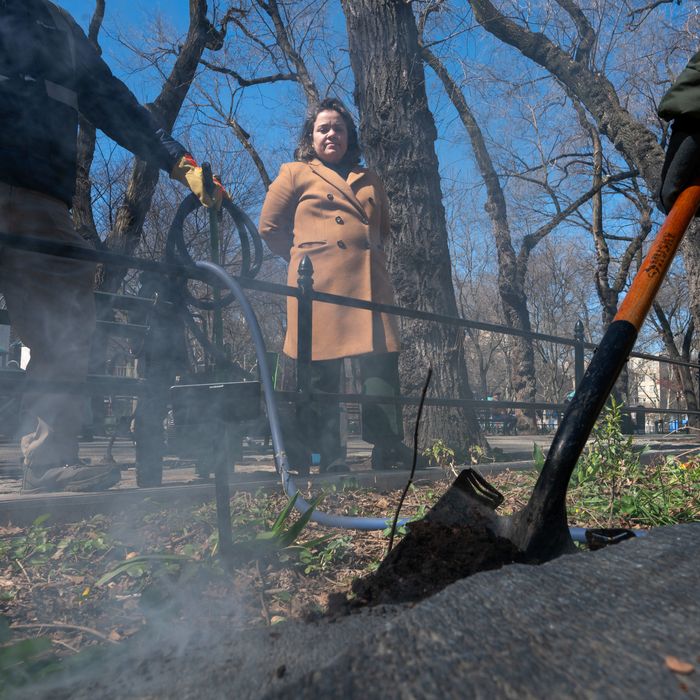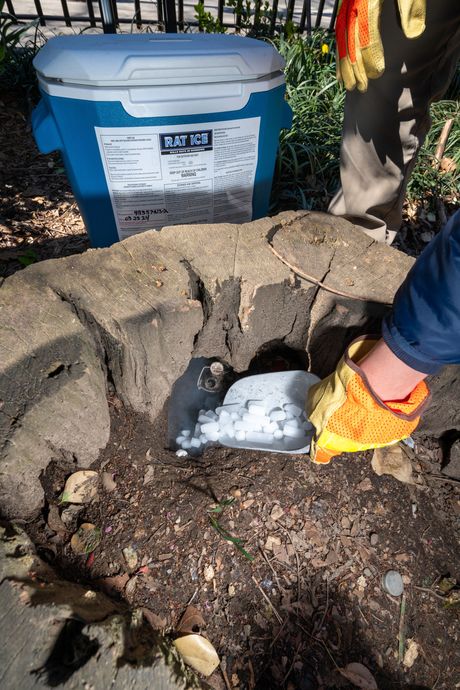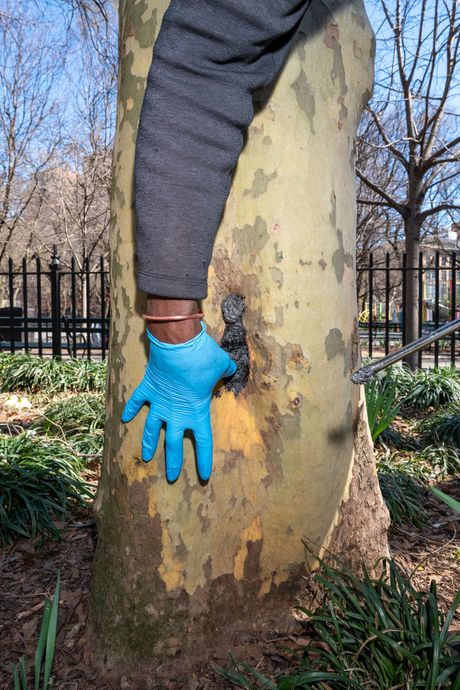
One sunny afternoon in March, the city’s rat czar, Kathleen Corradi, came to Seward Park to survey her domain.
It was treatment time for some rat burrows off Essex Street. Rats in this corner of the city have been known to cross the avenue in groups and bang up against the door of a taco shop. Exterminators for the Parks Department wheeled a BurrowRx machine to an area of low-lying greenery. “Perfect rat habitat,” Corradi said. “When something’s above them, they are happy. We want to make them less happy.”
The crew powered up the machine’s engine and plunged a hose into the first hole to fill it with deadly carbon monoxide. It is said that this device sounds to rats like an earthquake. Smoke escaped the entrances, and soil flew as the exterminators scrambled to cover hole after hole. The treatment is part of the “holistic approach” Corradi has heralded since landing her new $155,000-a-year job last April. “We’re really looking at systems-scale solutions,” she said.
That’s the mandate from her boss, Mayor Eric Adams, whose hatred of rats has long been appropriately visceral. As Brooklyn borough president, he wrote a Daily News op-ed shuddering about a plumber who had hauled away “40 bags of rats” from a NYCHA ceiling nest. Ensconced in Gracie Mansion, Adams can still summon the old disgust, saying last year in a TV interview that nothing could be more disruptive than “you start your day and a rat runs across your foot.”
But the rat battle goes beyond the ick factor for Adams, who has staked his mayoralty on improving quality-of-life issues for residents. The number of rat sightings exploded during the pandemic as work and trash patterns changed and the city paused some rat-control systems in favor of other priorities. So Adams declared war on the rats, and named a czar — a tool that has become a signature of his administration, and one whose effectiveness is still being tested. While Corradi’s mission is urgent, she has no direct staff to manage.
The rat challenge was on clear display in Seward Park last month. The city’s four “rat-mitigation zones,” including the neighborhoods around Seward Park, receive special attention owing to their “historic high rat burden and complaints,” Corradi said. The zone system was established by the City Council in 2022 and features special efforts such as metrics gathering. The park was undergoing treatment to address rat habitats, which can be in shiver-inducing places — like the cavity of a London plane tree that exterminators packed with steel wool and foam to seal off the den inside.


“Rats can fit through an opening the size of a quarter,” Corradi said with a trace of mirth. She’s also happy to spout the fact that rats can jump three feet, eat dog feces, and survive on something like an ounce of food a day.
Walking around the park, Corradi merrily identified evidence of rat activity such as sebum secretion and “kickback” of soil. She was careful to thank the Parks staffers doing the physical anti-rat work, at one point putting a hand on the shoulder of a grouter filling in cracks on the ground. She didn’t seem particularly worried by the prospect of seeing a rat, once stepping slowly away from a fist-size hole and noting dispassionately the downsides of a rat hopping up her wide green pant leg. Mostly, she evinced a bureaucratic admiration for the ingenuity of her foes. Pointing to a burrow entrance in the middle of a tree stump, Corradi observed that rats will sometimes disguise their homes.
“I saw one, they had a full baguette sticking out of a hole,” she said.
New attempts to reduce rats come around about as often as rat babies themselves, like the birth-control pilot program floated in the City Council last week. One of Corradi’s big roles — and strengths — as czar is to keep pushing the “integrated pest management” strategy of rat warfare. Habitats, for example, have to be identified all over a general area and then attacked repeatedly because rats will return to a burrow if it’s near a reliable food source.
Dealing with rodent food sources was part of Corradi’s work in the Department of Education’s Zero Waste Schools program. Before that, she taught at charter schools in Harlem and Central Brooklyn, and she has worked at the Brooklyn Botanic Garden. But the rat-czar gig has been a big jump into the limelight for the 35-year-old Crown Heights resident. Her neighbors were excited. “Affectionately, the folks at the dog park call my dog the rat prince,” she said, although Marvin, her Bernedoodle, is “not part of the rat-fighting efforts.” (For those curious, neither cats nor dogs appear to be much of a rat deterrent, she said.)
Some city officials have praised Corradi’s work so far. “She’s been very responsive,” says Councilmember Erik Bottcher, who invited the rat czar to his Manhattan district not long after she started the gig. They Citi Biked the area, which stretches from Hudson Square to Hell’s Kitchen, stopping at rodent hot spots along the way. Bottcher even shared a picture of Corradi, sunglasses perched atop of her head, coolly catching sight of a rat near a NYCHA property.
Corradi’s vision of the czar role includes getting various elements and products of city government to consider the rat. She did just that with the design requirements for new outdoor-dining structures regulated by the Department of Transportation. Bottcher described Corradi’s approach on that issue as “thoughtful”: She urged rat-resistant fixes such as filling barriers with water rather than the soil rats love. Corradi has also advocated for better cooperation between agencies in their rat-fighting tasks, as on “a full block of city-owned properties” in Harlem, where NYC Public Schools, Health, and NYCHA buildings are clustered. After a joint walk-through, Corradi said the Parks and NYCHA teams now do “coordinated visits” for the site, conducting treatments for burrows “on both sides of that property in one swoop.”
Such commonsense solutions are alluring, and they are the province of czars for all different topics who have worked under officials from Bill de Blasio to Joe Biden. But Corradi has limited sway compared with, say, a deputy mayor — which was actually the title held by Rudy Giuliani’s rat czar, Joe Lhota. He said Corradi has “the job of Sisyphus” and wishes her “all the luck in the world.” But as a deputy mayor for operations back then, he was able to forcefully pull together a team of people. “If she doesn’t have a team, she’s got to have the weight of the mayor,” Lhota said.
As with so many things Adams, there is a gimmicky quality to fighting rats. When he was borough president, he boosted pretty disgusting bucket traps meant to drown rats in an alcohol-based solution. (“That’s a thing of the past,” Corradi said.) The mayor’s press office hyped Corradi as “NYC’s First-Ever ‘Rat Czar,’” apparently leaping past Lhota. “There is no czar system,” said Scott Stringer, the former comptroller who is preparing a run against Adams for mayor. He pointed to Adams’s merry band of men and women put in charge of singular issues who are announced as, or quickly come to be called, “czars” — for the public realm, guns, AI, and efficiency as well as rats. Stringer called it “a cop-out system that convinces us, that attempts to convince New Yorkers, that a czar in and of itself can solve a major problem.”
There is one big, concrete way Adams has done more than signal his hatred of rats, and that’s his Sanitation Department’s monumental push to get trash out of bags and into containers. “Garbage intervention is key,” Corradi said, name-checking the initiative. Her success may ultimately depend on this policy shift, which is essentially out of her hands; it’s spearheaded by Adams and his Sanitation commissioner, Jessica Tisch, a press-savvy scion of one of New York’s premier philanthropic families. Tisch has made containerization her gritty mission, and fighting rats is something of a sideline. Months before Corradi got the rat-czar job, Tisch had a viral, T-shirt-ready slogan on the same subject: “The rats don’t run this city. We do.” Unlike Corradi, she also has abundant staff below her, in uniform and out, who can directly carry out her orders. “I imagine Tisch sees herself as the rat czar,” said one councilmember.
It’s possible that Tisch’s containerization drive may already be having an effect on rats. At a community conversation in Manhattanville last Monday, she and Adams defended an early pilot program for containerized trash, touting a “68 percent reduction in rat views” in the zone. Adams argued, “You’ll never get rid of rats if you have plastic bags on the street.”
But that same Manhattanville appearance exposed some of the challenges that lie ahead for Adams’s trash- and rat-fighting mission — one attendee called the trash pilot program “a failure and unacceptable.” Political controversy and pitfalls could very well arise as residents learn more about the new requirements for trash pickup, however well-intentioned the policy. Will Adams stay the course once the laudatory headlines are past? No commissioner or newly named czar can absorb all the blame if public opinion shifts.
While Adams and Corradi play up their war against rats, relatively little is actually certain about how to effectively fight the creatures. “I think there are just infinite challenges when it comes to rat management,” said Niamh Quinn, human-wildlife-interactions adviser at University of California Cooperative Extension. She notes that many commonly used anti-rat tools don’t work all that well. “The poor woman is taking on a task of trying to fix something, and she doesn’t know how it’s broken,” Quinn said of Corradi. “And it’s not just her, it’s everybody.”
She agrees that trash management could “go a good ways in reducing the number of rats,” though they could be finding food elsewhere.
Corradi is well aware of the unknowns. “We don’t really have good studies on establishing rat populations,” she explained in an April phone call, fresh off a rat inspection in the South Bronx. Counting 311 calls can help, and the Adams administration proudly announced a 20 percent citywide drop in rat-sighting calls this past summer compared with the previous one. But such numbers are hardly definitive. How about the rat-mitigation-zone system? “Still evaluating,” Corradi said.
About halfway through our visit to Seward Park, the rat czar mentioned an additional, cultural piece of the rat puzzle: human behavior.
“We’re a big part of the problem when it comes to sustaining rat populations in the city,” Corradi said.
We watched a man with a shopping cart of belongings feeding pigeons next to a bench. The crumbs will inevitably become rat food.
“If you’re gonna feed a bird, put a piece of bread down,” Corradi observed. Make sure it’s “consumed all the way.” When it comes to litter, people have to “do their part.”
Perhaps the newer rat-fighting initiatives will work, New Yorkers will start getting the memo, and rats will have a tougher time staying alive. But centuries of efforts have frequently shown otherwise. On a rainy night one week after the burrow treatment at Seward Park, a pair of ping-pong players raised a portable lamp over the public table, saying they often hear rats in the nearby bushes. One player pointed down a row of benches garlanded with an iced-coffee cup, dirty napkins, and a crumpled blue surgical mask. At the very end, on a ledge next to the rat burrow that the carbon-monoxide machine had so loudly and recently hosed, were three used clamshell containers that once held tacos. Limes and half-empty salsa cups soaked in the drizzle. I didn’t have to wait long. Just before midnight, a little gray rat ran from the taco clamshells back into the bushes. Home.





























